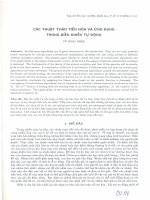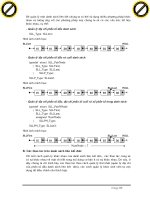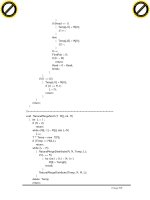Phân tích động mờ khung thép phẳng được giằng sử dụng thuật toán tiến hóa vi phân
Bạn đang xem bản rút gọn của tài liệu. Xem và tải ngay bản đầy đủ của tài liệu tại đây (561.17 KB, 3 trang )
Phân tích động mờ khung thép phẳng được giằng
sử dụng thuật toán tiến hóa vi phân
Fuzzy dynamic analysis of 2d-braced steel frame using differential evolution optimization
Viet T. Tran, Anh Q. Vu, Huynh X. Le
Tóm tắt
Bài báo nghiên cứu áp dụng thủ tục phần tử hữu
hạn mờ phân tích động kết cấu khung thép phẳng
với các đại lượng đầu vào mờ. Các hệ số liên kết
giữa dầm – cột, cột – móng, tải trọng, khối lượng
riêng và hệ số cản được mô tả dưới dạng các số mờ
tam giác. Phương pháp tích phân số β – Newmark
được áp dụng xác định chuyển vị trong hệ phương
trình cân bằng động tuyến tính. Phương pháp tối
ưu mức – α sử dụng thuật toán tiến hóa vi phân
được tích hợp với mô hình phần tử hữu hạn để
phân tích động kết cấu mờ. Hiệu quả của phương
pháp đề xuất được minh họa thông qua ví dụ liên
quan đến khung thép phẳng hai mươi lăm tầng,
ba nhịp được giằng tập trung.
Từ khóa: Khung thép giằng, liên kết mờ, động lực kết cấu
mờ, thuật toán tiến hóa vi phân
Abstract
1. Introduction
In the dynamic analysis of steel frame structures with semi-rigid
connections, rigidity of the connection (or fixity factor of the connection),
loads, mass per unit volume, damping ratio … have a significant influence
on the time – history response of steel frame structure [4]. In practice,
however, many parameters like worker skill, quality of welds, properties
of material and type of the connecting elements affect the behavior of a
connection, and this fixity factor is difficult to determine exactly. Therefore, in
a practical analysis of structures, a systematic approach need to include the
uncertainty in the connection behavior, and the fixity factor of a connection
modeled as the fuzzy number is reasonable [5]. In addition, the uncertainty
of input parameters is also described in form of fuzzy numbers, such as
external forces, mass per unit volume and damping ratio. In this paper, the
fuzzy displacement - time dependency of a planar steel frame structure
is determined in which the fixity factor, loads, mass per unit volume, and
damping ratio are described in the form of any triangular fuzzy numbers.
A procedure is based on finite element model by combining the α – level
optimization with the Differential Evolution algorithm (DEa). The Newmark-β
average acceleration numerical integration method is applied to determine
the displacements from the linear dynamic equilibrium equation system of
the finite element model.
This paper studies the application of the fuzzy finite
2. Finite element with linear semi-rigid connection
element procedure for dynamic analysis of the planar
The linear dynamic equilibrium equation system is given as following
semi-rigid steel frame structures with fuzzy input
parameters. The fixity factors of beam – column and
[ M ]{u} + [C ]{u} + [ K ]{u} =
{P ( t )}
(1)
column – base connections, loads, mass per unit
where
u
,
u
,
and
u
are
the
vectors
of
acceleration,
velocity,
and
{
}
{
}
{
}
volume and damping ratio are modeled as triangular
displacement respectively; [M], [C], and [K] are the mass, damping, and
fuzzy numbers. The Newmark-β numerical integration
stiffness matrices respectively; {P(t)} is the external load vector. The viscous
method is applied to determine the displacement of
damping matrix [C] can be defined as
the linear dynamic equilibrium equation system. The
α – level optimization using the Differential Evolution
=
[C ] α M [ M ] + β K [ K ]
(2)
(DE) integrated finite element modeling to analyse
where
αM
and
βK
are
the
proportional
damping
factors
which
defined
as
dynamic of fuzzy structures. The efficiency of proposed
methodology is demonstrated through the example
2ω1ω2
2
α M ξ=
ξ
=
;β
problem relating to the twenty-five – story, three – bay
ω1 + ω2 K
ω1 + ω2
(3)
concentrically braced frame.
where
ξ
is
the
damping
ratio;
ω
and
ω
are
the
natural
radian
frequencies
1
2
Keywords: braced steel frame, fuzzy connection, fuzzy
of the first and second modes of the considered frame, respectively.
structural dynamic, differential evolution algorithm
MS. Viet T. Tran
Faculty of civil engineering, Duy Tan University
Email: <>
Ass. Prof. Anh Q. Vu
Faculty of civil engineering
Hanoi Architectural University
Email: <>
Prof. Huynh X. Le
Faculty of civil engineering
National University of Civil Engineering
Email: <>
In this study, the frame element with linear semi – rigid connection is
shown in Fig. 1, with E - the elastic modulus, A – the section area, I – the
inertia moment, m - the mass per unit volume, k1 and k2 – rotation resistance
stiffness at connections.
The element stiffness matrix - [Kel] and the mass matrix - [Mel] of the
frame are given by [4], with si = Lki / (3EI + Lki) denote the fixity factor of
semi – rigid connection at the boundaries (i = 1,2). In Eq. (1), when fixity
factors of connections, external loads, mass per unit volume and damping
ratio are given by fuzzy numbers, the displacements of joints are also fuzzy
numbers. In steel structures, the common fuzzy connections can be defined
by linguistic terms as shown in Fig. 2. Eleven linguistic terms are assigned
numbers from 0 to 10 ( si = 0,1,...10 ) [5].
In the classical finite element method (FEM), in Eq. (1), the displacement
– time dependency of the joints is determined by solving the linear dynamic
equilibrium equation system. The Newmark-β method has been chosen for
S¬ 27 - 2017
45
KHOA H“C & C«NG NGHª
Figure 1. Frame element with
linear semi-rigid connection
Figure 2. Membership functions of fuzzy fixity factors
Figure 4. Fuzzy displacement-time response at joint
26 in x direction
Figure 3. Concentrically braced steel frame with
fuzzy input parameters
Figure 5. The membership functions of fuzzy
displacement at joint 26
the numerical integration of this equation system because of
its simplicity [1]. The fuzzy displacement is determined by the
fuzzy finite element method (FFEM) using the α-cut strategy
with the optimization approaches. FFEM is an extension of
FEM in the case that the input quantities in the FEM are
modeled as fuzzy numbers. In this study, an optimization
approach is presented in the next sections: the differential
evolution algorithm (DEa).
The displacement of the joint at each time step is
determined by this algorithm of linear elastic dynamic
analysis.
3. Proceduce for fuzzy structural dynamic analysis
3.1. Linear elastic dynamic analysis algorithm
The Newmark-β method is based on the solution of an
incremental form of the equations of motion. For the equations
of motion (1), the incremental equilibrium equation is:
[ M ]{∆u} + [C ]{∆u} + [ K ]{∆u} ={∆P} (4)
where {u} , {u} , and {u} are the vectors of incremental
acceleration, velocity, and displacement respectively; {∆P} is
the external load increment vector.
46
3.2. α – level optimization using Differential Evolution
algorithm (DEa)
For fuzzy structural analysis, the α-level optimization is
known as a general approach in which all the fuzzy inputs
are discretized by the intervals that are equal α-levels.
The output intervals are then searched by the optimization
algorithms. The optimization process is implemented directly
by the finite element model and the goal function is evaluated
many times in order to reach to an acceptable value. In this
study, the output intervals are the displacement intervals at
each time step, and the solution procedure is proposed by
combining the Differential Evolution algorithm (DEa) with
the α-level optimization. The DEa has shown better than the
genetic algorithm (GA) and is simple and easy to use. Basic
procedure of DEa is described as [6].
T„P CHŠ KHOA H“C KI¦N TR”C - XŸY D¼NG
Table 1: Section properties used for analysis of the portal steel frame
Section
Cross – section area, A (m2)
Moment of inertia, I (m4)
Column (1st to 4th story)
W30x391
7.35E-02
8.616E-03
Column (5th to 8th story)
W30x326
6.17E-02
6.993E-03
Column (9th to 14th story)
W27x307
5.82E-02
5.453E-03
Column (15th to 20th story)
W24x306
5.79E-02
4.454E-03
Beam (1st to 20th story)
W24x250
4.74E-02
3.534E-03
Member
4. Numerical illustration
A twenty-five – story, three – bay concentrically braced
frame subjected to fuzzy impulse force as shown in Fig. 3
1 = (7.85,
is considered. The fuzzy input parameters are: m
2 = (50, 5, 5), s1 =9, s2 = 8, s3 = 7, s4 = 6,
0.785, 0.785), m
s5 =5, s6 =1. The fuzzy damping ratio is ξ = (0.05, 0.005,
0.005). The fuzzy impulse force is: P ( t ) = P (0 ≤ t ≤ 3 s), and
P ( t ) = 0 (t > 3 s), with P = (40, 4, 4). These fuzzy terms
are considered to be triangular fuzzy numbers with 20%
absolute spread. A time step Δt of 0.05 second is chosen in
the dynamic analysis. The output intervals of displacement
are calculated by using DE programmed by MATLAB. The
section properties used for analysis of the frame are shown
in Table I.
Fig. 4 shows the fuzzy displacement-time response and
the membership functions of fuzzy displacement at different
times in 3D – axis. Fig. 5 shows the membership functions
of fuzzy displacement and the deterministic displacement (at
Tài liệu tham khảo
1. N. M. Newmark. A method of computation for structural
dynamic. Journal of the Engineering Mechanics Division, ASCE,
vol. 85 (1959) 67-94.
2. R. Storn, and K. Price. Differential Evolution – A Simple and
Efficient Heuristic for Global Optimization over Continuous
Spaces. Journal of Global Optimization 11, Netherlands, (1997)
341-359.
3. M. Hanss. The transformation method for the simulation and
analysis of systems with uncertain parameters. Fuzzy Sets and
Systems 130(3) (2002) 277-289.
4. V. Q. Anh, N. M. Hien. Geometric nonlinear vibration analysis
of steel frames with semi-rigid connections and rigid zones.
Vietnam Journal of Mechanics, VAST 25 (2) (2003) 122-128.
central value) from the SAP2000 software, with t = 1.10, 2.05,
2.90, 4.05, 5.10, and 6.00 seconds.
5. Conclusion
A fuzzy finite element analysis based on the Differential
Evolution (DE) in combination with the α – level optimization,
in which the Newmark-β average acceleration method is
applied to determine the deterministic displacement. The
fuzzy input parameters such as fixity factors of connections,
external forces, mass per unit volume, and damping ratio
have a significant influence on the time dependency of the
fuzzy displacement. With the example is considered, fuzzy
displacments show more different shapes of membership
functions at different times. Moreover, these fuzzy
displacements have absolute spreads from 40% to 150%. In
adition, the determinant results are also compared with ones
of the SAP2000 software and give a good agreement./.
5. A. Keyhani, S. M. R. Shahabi. Fuzzy connections in structural
analysis. ISSN 1392 – 1207 MECHANIKA, 18(4) (2012) 380386.
6. M. M. Efrén, R. S. Margarita, A. C. Carlos. Multi-Objective
Optimization using Differential Evolution: A Survey of the Stateof-the-Art. Soft Computing with Applications (SCA), 1(1) (2013).
7. P. H Anh, N. X. Thanh, N. V. Hung. Fuzzy Structural Analysis
Using Improved Differential Evolution Optimization.
International Conference on Engineering Mechanic and
Automation (ICEMA 3), Hanoi, October 15-16 (2014) 492-498.
8. T. T. Viet, V. Q. Anh, L. X. Huynh. Fuzzy analysis for stability of
steel frame with fixity factor modeled as triangular fuzzy number.
Advances in Computational Design 2(1) (2017) 29-42.
S¬ 27 - 2017
47









